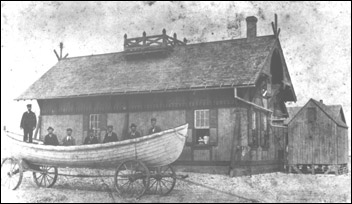Last updated: August 2, 2023
Lesson Plan
Little Kinnakeet Lifesaving Station: Home to Unsung Heroes

- Grade Level:
- Middle School: Sixth Grade through Eighth Grade
- Subject:
- Literacy and Language Arts,Social Studies
- Lesson Duration:
- 90 Minutes
- Common Core Standards:
- 6-8.RH.2, 6-8.RH.3, 6-8.RH.4, 6-8.RH.5, 6-8.RH.6, 6-8.RH.7, 6-8.RH.8, 6-8.RH.9, 6-8.RH.10, 9-10.RH.1, 9-10.RH.2, 9-10.RH.3, 9-10.RH.4, 9-10.RH.5, 9-10.RH.6, 9-10.RH.7, 9-10.RH.8, 9-10.RH.9, 9-10.RH.10
- Additional Standards:
- US History Era 5 Standard 2A: The student understands how the resources of the Union and Confederacy affected the course of the war.
Curriculum Standards for Social Studies from the National Council for the Social Studies - Thinking Skills:
- Remembering: Recalling or recognizing information ideas, and principles. Understanding: Understand the main idea of material heard, viewed, or read. Interpret or summarize the ideas in own words. Applying: Apply an abstract idea in a concrete situation to solve a problem or relate it to a prior experience. Analyzing: Break down a concept or idea into parts and show the relationships among the parts. Creating: Bring together parts (elements, compounds) of knowledge to form a whole and build relationships for NEW situations. Evaluating: Make informed judgements about the value of ideas or materials. Use standards and criteria to support opinions and views.
Essential Question
Where did the United States Lifesaving Service work? What did it do? What historic place could you study to answer these questions?
Objective
1. Understand why the Federal Government took an active role in protecting mariners by creating the U.S. Lifesaving Service;
2. Explain the nature of duty in the U.S.L.S.S., including the daily routine and rescue activities;
3. Describe how the U.S.L.S.S. was perceived by some of the Atlantic Coast sailors whose lives were saved;
4. Examine modern rescue methods in their community and to compare them to U.S. Lifesaving Service operations.
Background
Time Period: 1870s to 1910s
Topics: The lesson could be used in U.S. history, social studies, and geography courses in units on 19th-century commerce or transportation, civics, or the chronological period after Reconstruction. Little Kinnakeet will help students understand the need for the U.S. Lifesaving Service (U.S.L.S.S.), a government agency that often has been forgotten but was responsible for saving more than 175,000 lives during its 44 years of operation. In 1915 the U.S.L.S.S. merged with the U.S. Revenue Cutter Service to become the U.S. Coast Guard.
Preparation
Bellowing its rage like a thunderous symphony, the Atlantic Ocean throws itself once more against the narrow bastion of North Carolina's barrier islands. Storm winds shriek above the roaring breakers, and carry with them a blinding flurry of sand and sea-foam. Bird and beast alike have fled the unyielding fury of the storm, for nothing can withstand this powerful onslaught of nature. Merciless waves will overwhelm ships caught in the turmoil or drive them ashore to be smashed to pieces in the pounding surf. Yet for this very reason a lifesaver from Little Kinnakeet Lifesaving Station struggles amidst this forbidding storm, patrolling the beach in search of shipwrecks where mariners might be in need of assistance.
Little Kinnakeet Lifesaving Station is an excellent reminder of the stations constructed by the U.S. Lifesaving Service (U.S.L.S.S.) during its 44-year existence (1871-1915). The original station building was among the first seven constructed on North Carolina's treacherous Outer Banks in 1874. A larger building was added in 1904, and the site remained active under the U.S. Coast Guard until 1954, when it was decommissioned and transferred to the National Park Service as a part of Cape Hatteras National Seashore. It still stands among the windblown sands of Hatteras Island, untouched by development and a poignant monument to the lifesavers it once housed.
Materials
Lesson Hook/Preview
When the Southern states first considered secession, most people believed that if war came, it would be brief. They did not envision four years of fighting that would lead to cruel deaths and the thousands that were captured as prisoners of war. In 1862 a system of parole and exchange was informally adopted by the Union and Confederate governments. A "paroled" prisoner pledged not to participate in the war or assist his allies. He would often be released on the spot to proceed to a camp where paroled soldiers were concentrated until the two governments officially exchanged prisoners. He could then return to the military. In the fall of 1863, the U.S. government suspended exchanges. The growing number of captured soldiers soon began filling Union and Confederate prisons.
Although conditions were bad in both Southern and Northern prison camps, the large number of prisoner deaths at Georgia's Andersonville Prison combined with the defeat of the Confederate states resulted in national attention and public outrage on the treatment of Union prisoners there.
Procedure
Getting Started Prompt
Map: Orients the students and encourages them to think about how place affects culture and society
Readings: Primary and secondary source readings provide content and spark critical analysis.
Visual Evidence: Students critique and analyze visual evidence to tackle questions and support their own theories about the subject.
Optional post-lesson activities: If time allows, these will deepen your students' engagement with the topics and themes introduced in the lesson, and to help them develop essential skills.
Additional Resources
The Little Kinnakeet Lifesaving Station is located within Cape Hatteras National Seashore. The seashore was home to over ten Life-Saving Service stations.
United States Life Saving Service on the Outer Banks
United States Coast Guard Heritage Asset Program
United States Life Saving Service Heritage Association
